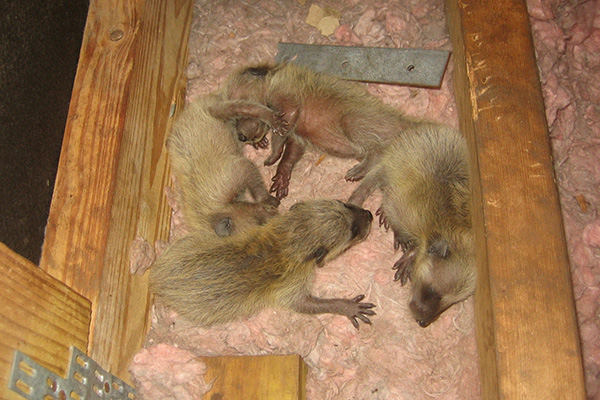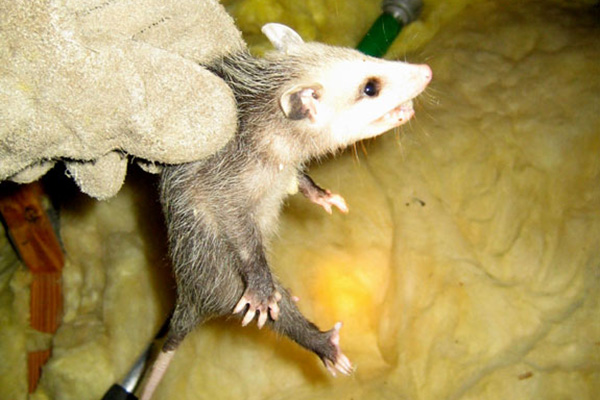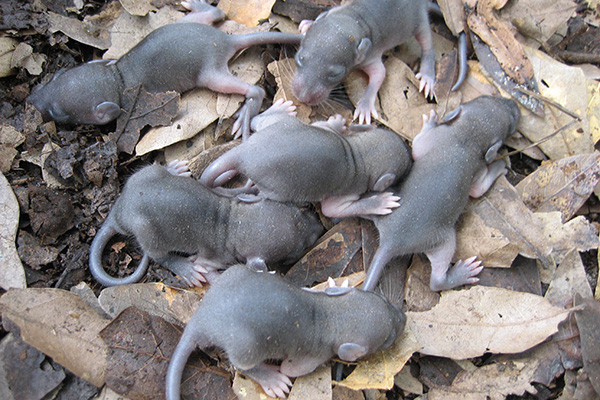- info@animalatticpest.com
- Call - we service 300 locations

Nest of Baby Animals in the Attic
Did you know that the #1 reason a wild critter goes into an attic is to have a safe place to give birth, and raise a nest of babies? It's true. Almost every time, a single pregnant female, on the hunt for a safe
den, makes its way into your attic, looking for safe shelter for the upcoming litter. She gives birth, and spends as much time in the attic as necessary to succesfully raise the young. For a squirrel, this only takes a
few months. For a raccoon, it takes most of the year. For rats and mice, they simply breed year-round.
You can't simply trap the adult and call it good. If you do that, you'll remove a nursing female, and leave the young up in the attic to starve and die! It's not only inhumane, but the young, depending on age, might manage
to claw or scratch their way into your house, or if not, they'll die and decompose, and the odor is terrible. Please don't leave the young up in the attic!
You must inspect the attic carefully, and find the litter of young, and put them in a pillowcase or bucket. In the case of raccoons and sometimes even squirrels, you can use the young as "live bait" in the back of a large
cage trap, and it's the most effective way in the world to lure in the mother. Then you will have them all together, and you can relocate them together.
Learn more about baby wildlife in the attic. Read about Nest of Baby Raccoons, or Nest of Baby Squirrels, or Nest of Baby Rats, or
Nest of Baby Mice, or Baby Bats in Attic
Nest of Baby Animals in the Attic
Baby Raccoons
90% of the time, an adult raccoon in an attic is a single female with a litter of 3-5 baby raccoons. You absolutely MUST remove them along with the mother raccoon.
Baby Squirrels
Female squirrels usually use an attic as a nesting place. They have two litters of young per year, in late winter and late summer. The young grow very fast.
Baby Opossums
If you have an opossum in the attic during the spring, it's often a female. The young aren't in a nest, though. The mother IS the nest - they live in a pouch.
Information About Nest of Baby Animals in the Attic
Having animals living in your attic is always a problem, but it can become even more complicated when there is a nest of baby animals in the attic. Baby animals come with their own unique set of concerns since you want to treat them and their mother humanely. In any case, separating the babies from their mother will be inhumane and a death sentence for the young as they will have no access to food. Multiple species of wildlife that can live in the attic will also become very distraught when separated from their babies, including squirrels, and repeatedly attempt to break back into the attic. Because of these concerns, it is important to take care of baby animals appropriately at all times.
Identifying Babies And Type Of Wildlife
The first step to taking care of a nest of baby animals in the attic is to confirm that babies are indeed present. You can do this with a visual confirmation if you are able to get close to the attic, but be careful when doing so. It is also very easy to tell whether babies are present based on the time of the year as each type of animal has its own maternity season, typically during the summer months but with some variation. You will also have to check what type of wildlife you have in your attic since the actions you take will vary slightly depending on the species.
Read about Nests in the Attic to learn how to identify.
Check If It Is Legal To Move Them
Once you have determined that babies are present, you need to figure out whether it is legal to move them. Certain species, such as bats, are protected because of their usefulness in eating insects and their slow reproduction rates. Because of this, you cannot legally move bats during the maternity season which lasts between April and August depending on the type of bat. Other animals may have similar legal restrictions, so always do research before taking action.
Ideally Wait Until They Grow
Even if the type of animal in your attic is not protected by the law during maternity season, you should wait until the nesting babies grow before removing them. This will make the process significantly smoother since they may simply leave of their own free will once they become old enough to become independent. Additionally, once the baby animals in your attic are older, you will be able to use the same removal methods on them as you would on any other adult, such as humane exclusion.
Can Trap And Remove With Care
In some cases, you will need to get the nest of baby animals in the attic out right away and although complicated, this is possible with some expert help. Only remove the baby animals if it is legal in your area and there is not a better option available. No matter the circumstances, you should always keep the babies and mother together. Otherwise, the mother will go through an incredibly stressful situation and the babies are likely to die or require intensive care from an animal rehabilitator who will have to act as their mother.
There are two main methods of trapping and removing the babies and their mother together. Traditional cage traps will not work with young animals since they are too small. Because of this, you typically have to physically go into the attic and grab the nesting animals while wearing gloves and put them in a cage. If the mother is out of the attic, you can do this and then use the babies as bait to catch the mother when she returns. Alternatively, you can set up a live cage trap for the mother and then physically remove the babies to join her after she is caught. With either method, you must make sure the animals are not separated for long and all wildlife involved, both adults and babies, are protected from the elements and have access to food and water while in their cages. You would then relocate the family of animals together.
Important Considerations
The most important consideration when taking care of a nest of baby animals in the attic is to always keep the mother and her babies together. Remember that failing to do so is inhumane and leads to certain death of the babies unless you step in and give them hourly care. You should also be on the lookout for signs of aggression from the mother whenever you approach her or her young. It is common for wildlife to be protective of their young and this can lead to you being bitten or scratched if you aren’t careful. You also need to always seal up all entrances to your attic after removing the animals; otherwise, new ones will just come to take their place. Because wildlife removal becomes significantly more complicated when babies are involved, you should always hire a professional to help you in this type of situation. They will be aware of the best humane methods for removal and be able to do so without injury.
The Bottom Line
Pay attention to the species of animal and the time of year, and be aware that 90% of the time, the animal in your attic is a female with young. In fact, you might not even notice them until the young grow old enough to run around, at which time you hear several animals in your attic - the mother and the juveniles.




